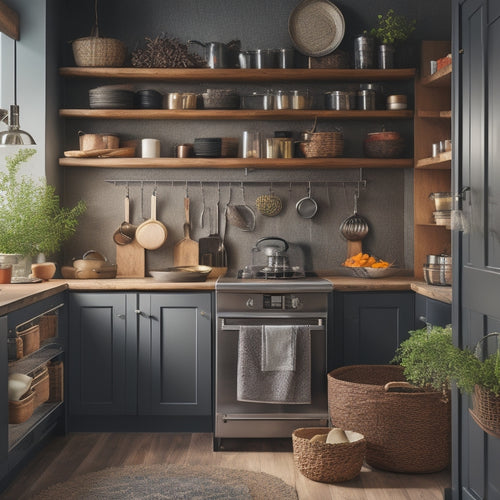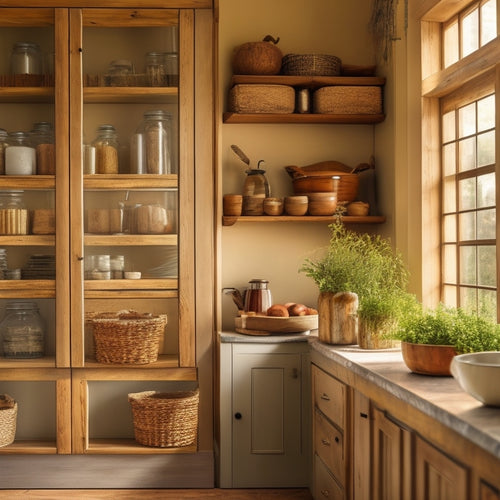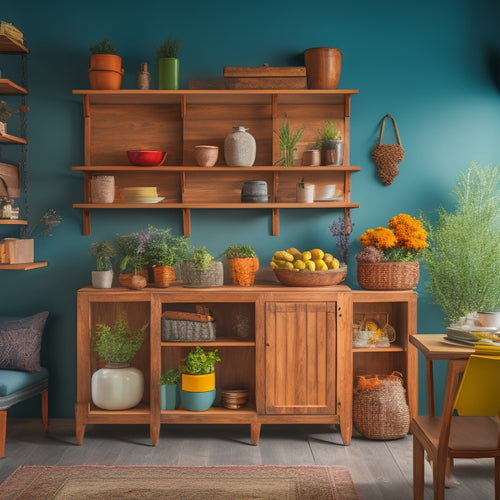
What Makes a Kitchen Aging-in-Place Friendly?
Share
You're designing a kitchen that will allow you to age in place comfortably, and that means incorporating features that accommodate your changing needs and abilities over time. To create an aging-in-place friendly kitchen, start by designing clear pathways and layouts that make it easy to move around. Install adequate lighting, including task lighting and natural light, and choose countertops and shelving that are accessible and adjustable. Consider ergonomic stools, non-slip flooring, and smart appliances that are easy to use. By incorporating these features, you'll be able to cook, socialize, and enjoy your kitchen with confidence - and discover even more ways to make your kitchen a haven as you explore further.
Key Takeaways
• A well-designed layout with clear pathways, rounded corners, and ample space for maneuverability enables easy navigation for aging individuals.
• Customizable countertops, shelving, and storage solutions with adjustable heights and easy-to-grasp handles promote accessibility and comfort.
• Warm white energy-efficient lighting, task lighting, and motion-sensing lights enhance visibility, convenience, and safety in the kitchen.
• Ergonomic features like adjustable stools, posture reminders, non-slip floor mats, and slip-resistant surfaces reduce fatigue and prevent accidents.
• Integration of technology, such as voice assistants, smart sensors, and meal preparation assistance devices, supports independence and ease of use in the kitchen.
Clear Navigation and Pathways
As you plan to age in place, make sure your kitchen's layout allows you to navigate through it safely and easily by maintaining clear pathways and minimizing obstacles. A well-designed kitchen should provide a comfortable and accessible space for you to move around, even as your mobility changes.
One key aspect to ponder is pathway width. Aim for a minimum of 36 inches between countertops, appliances, and islands to guarantee you can pass through comfortably. Wider pathways will give you more room to maneuver, especially if you use a walker or wheelchair.
Another important element is the corner radius. Rounded corners can help prevent injuries and make it easier to navigate through tight spaces. Opt for a corner radius of at least 1 inch to create a smoother shift between countertops and walls.
Adequate Lighting and Visibility
You'll want to make sure your kitchen is well-lit, with a combination of task, ambient, and natural light sources that allow you to see clearly and comfortably, even as your vision changes over time. Adequate lighting and visibility are vital for safety and independence in the kitchen.
As you age, your eyes may have difficulty adjusting to changes in light, making it harder to read recipes, identify food, or navigate the space.
Here are some tips to make sure your kitchen is well-lit:
-
Choose the right color temperature: Warm white light (2700K-3000K) is easier on the eyes than cool white light (3500K-5000K).
-
Increase task illumination: Install under-cabinet lights or pendant lights above countertops to reduce shadows and improve visibility.
-
Maximize natural light: Keep windows unobstructed and consider skylights or larger windows to bring in more natural light.
-
Use LED light bulbs: They're energy-efficient and can be adjusted to different brightness levels.
-
Consider motion-sensing lights: They can be especially helpful for those with mobility or dexterity issues.
Comfortable Standing and Seating
When thinking about age, standing for extended periods can become exhausting, making comfortable seating options and adaptable standing arrangements essential for maintaining independence and enjoyment in the kitchen.
You'll want to contemplate incorporating ergonomic stools with adjustable heights and armrests to provide support and relief. These stools can be especially helpful when you're preparing meals or working at a counter.
Additionally, ponder adding posture reminders throughout your kitchen, such as a mirror or a sticker on the wall, to encourage good posture and reduce strain on your back and joints.
When standing, make sure you have a comfortable and stable surface to stand on. A non-slip mat or a cushioned floor mat can make a big difference.
You may also want to think about adding a sit-down area, like a built-in banquette or a comfortable chair, where you can take a break and rest your feet.
Accessible Storage and Shelving
Frequently, kitchen storage and shelving can become a significant obstacle as you age, making it essential to design accessible solutions that accommodate your changing needs. You deserve a kitchen that adapts to your evolving requirements, not one that becomes a hindrance to your daily life.
To create an aging-in-place friendly kitchen, consider the following accessible storage and shelving features:
-
Adjustable compartments that can be customized to fit your changing needs
-
Customizable configurations that allow you to reorganize your storage as needed
-
Pull-out shelves and drawers that reduce bending and straining
-
Open shelving with easy-to-grasp handles and minimal obstacles
-
Lowered countertops and shelving to reduce reaching and stretching
Easy-to-Use Appliances and Fixtures
As you design your kitchen for aging-in-place, incorporating easy-to-use appliances and fixtures can greatly enhance your overall cooking experience, allowing you to maintain independence and confidence in the heart of your home.
You'll want to focus on features that simplify meal prep and cooking tasks. For instance, consider installing appliances with intuitive controls, such as smart displays that provide clear instructions and visual cues. These features can be especially helpful for individuals with cognitive or visual impairments.
Additionally, touchless faucets can be a game-changer, eliminating the need to grasp or turn handles, which can be challenging for those with arthritis or dexterity issues. Look for fixtures with single-handle operation or sensor-activated controls that allow for effortless water flow.
Slip-Resistant Flooring and Surfaces
As you design your kitchen for aging-in-place, you'll want to prioritize slip-resistant flooring and surfaces to guarantee your safety.
You'll need to take into account the grip level of your flooring, as well as the texture and pattern, to create a secure environment.
Additionally, selecting materials with moisture resistance will help prevent slippery surfaces and give you peace of mind.
Grip Levels Matter
You'll want to prioritize slip-resistant flooring and surfaces in your kitchen, as a single fall can have devastating consequences, especially for older adults or people with mobility issues. Grip levels matter, and it's crucial to take into account the tactile feedback and finger strength required to navigate your kitchen safely.
Here are some key considerations to make sure your kitchen flooring and surfaces provide the necessary grip:
-
Textured surfaces: Incorporate flooring and countertops with textured surfaces to provide better traction and grip.
-
Non-slip coatings: Apply non-slip coatings to slippery surfaces, such as ceramic tiles or polished wood, to increase grip.
-
Ramps and mats: Install ramps and mats with textured surfaces at entry points and in front of sinks and stoves to reduce slipping hazards.
-
Grip-enhancing materials: Use grip-enhancing materials, like rubber or cork, for flooring and countertops to provide better traction.
-
Clear walkways: Maintain clear walkways and minimal clutter to reduce tripping hazards and allow for easy navigation.
Texture and Pattern
When selecting slip-resistant flooring and surfaces, it's important to choose textures and patterns that offer superior traction, as subtle variations in design can greatly affect safety and mobility in your kitchen.
You want to make sure that the flooring and surfaces you choose provide a secure grip, even when wet or oily. A tactile experience is essential, as it allows individuals to feel the texture and pattern of the surface, providing an added layer of safety.
In addition to providing traction, the texture and pattern you choose can also add visual interest to your kitchen. A well-designed surface can create a sense of warmth and comfort, making the space feel more inviting.
Consider combining different textures, such as matte and glossy finishes, to create visual interest. Additionally, incorporating patterns, like chevrons or hexagons, can add depth and visual appeal.
Moisture Resistance Counts
Since texture and pattern play a significant role in preventing slips and falls, it's equally important to take into account the moisture resistance of your kitchen flooring and surfaces. As you design your aging-in-place kitchen, remember that moisture can seep into surfaces, making them hazardous.
To guarantee safety, consider the following:
-
Choose waterproof materials for your flooring, such as ceramic or porcelain tiles, and seal them regularly to maintain their water-repelling properties.
-
Install humidity sensors to detect excess moisture in the air, alerting you to take action before it becomes a problem.
-
Opt for slip-resistant surfaces, like textured vinyl or rubber, which provide traction even when wet.
-
Consider a drainage system, like a sloping floor or a central drain, to direct water away from walkways.
-
Don't forget to apply a non-slip coating to your surfaces, providing an extra layer of protection against slips and falls.
Adaptive Countertops and Workspaces
As you design your aging-in-place kitchen, you're probably thinking about how to make meal prep and cooking easier and more comfortable. That's where adaptive countertops and workspaces come in - they can be tailored to your specific needs and abilities.
Height Adjustable Surfaces
You can easily shift between cooking, baking, and food preparation tasks with height adjustable surfaces, which allow you to customize the countertop and workspace to your comfort level. This adaptive feature is especially beneficial for individuals who require ergonomic comfort while cooking.
With height adjustable surfaces, you can adjust the countertop to a comfortable height that reduces strain on your back and joints, allowing you to cook with ease.
Here are some benefits of height adjustable surfaces:
-
Customization options: Choose from various height settings to accommodate different users or tasks.
-
Ergonomic comfort: Reduce strain on your back and joints by working at a comfortable height.
-
Increased accessibility: Enable individuals with mobility issues to participate in cooking activities.
-
Improved productivity: Work more efficiently with a countertop that's tailored to your needs.
-
Enhanced safety: Reduce the risk of accidents by working at a comfortable height that minimizes stretching and bending.
Easy Grip Edges
By incorporating easy grip edges into your adaptive countertops and workspaces, you'll find it simpler to navigate your kitchen, even when your hands are wet, oily, or arthritic. This thoughtful design element can make a significant difference in the daily lives of individuals with mobility or dexterity impairments. Easy grip edges provide a secure surface to grasp, reducing the risk of accidents and injuries.
When selecting handle materials, consider durable, non-slip options like textured wood, rubber, or contoured metal. These materials can provide a comfortable grip, even for those with limited hand strength.
Edge profiles also play an important role in easy grip edges. Rounded or chamfered edges can help guide your hands along the countertop, while flat edges with a slight lip can provide a secure surface to grasp.
Technology Integration for Support
Smart home devices and wearables can seamlessly integrate into your kitchen to provide support and safety, allowing you to maintain independence while aging in place. As you navigate your kitchen, technology can be your trusted companion, assisting with daily tasks and providing peace of mind.
Here are some ways technology can support you:
-
Voice Assistants: Use voice commands to control lighting, temperature, and appliances, reducing the need for physical exertion.
-
Smart Sensors: Install sensors that detect falls, monitor medication schedules, and track daily routines, enabling prompt assistance when needed.
-
Automated Lighting: Program lights to turn on and off, reducing tripping hazards and improving visibility.
-
Meal Preparation Assistance: Utilize devices that provide step-by-step cooking instructions and monitor cooking temperatures, ensuring a safe and enjoyable meal prep experience.
-
Emergency Response Systems: Install systems that allow you to quickly call for help in case of an emergency, providing an added layer of safety and security.
Universal Design Elements Incorporated
Incorporating universal design elements into your kitchen guarantees that the space remains accessible, comfortable, and safe as your needs evolve over time. By integrating these elements, you'll create a kitchen that's not only beautiful but also functional and inclusive.
You can start by selecting a color scheme that's easy on the eyes. A palette with high contrast between surfaces, such as light countertops and dark cabinets, makes it easier to navigate the space. Additionally, take into account acoustic comfort by incorporating sound-absorbing materials like acoustic panels or soft furnishings. This will reduce echo and create a more peaceful cooking environment.
Other universal design elements to take into account include wide, clear pathways; ample counter space; and accessible storage. You can also install lever-handled faucets, touchless appliances, and adjustable lighting to make the space more user-friendly.
Frequently Asked Questions
Can I Age-In-Place With a Small Kitchen Footprint?
You can still age-in-place with a small kitchen footprint by prioritizing space planning and corner optimization, using clever storage solutions and multi-functional appliances to create a functional, accessible space that works for you.
Are There Any Specific Aging-In-Place Certifications for Kitchens?
Imagine your grandma, struggling to navigate her kitchen due to mobility issues. You'll be relieved to know that there are specific aging-in-place certifications for kitchens, like the Certified Aging-in-Place Specialist (CAPS) certification, which involves a rigorous designer training and certification process.
How Do I Balance Aesthetics With Accessibility in My Kitchen Design?
To balance aesthetics with accessibility, you'll incorporate Universal Design principles, blending Luxury Features with thoughtful details, ensuring your kitchen design is both beautiful and functional for everyone, regardless of age or ability.
Can I Incorporate Smart Home Devices for Safety and Convenience?
"Smoothly sync smart home devices into your kitchen design, incorporating voice assistants and fall detection features that seamlessly safeguard and serve you, allowing you to age comfortably in your dream space."
Are There Any Government Incentives for Aging-In-Place Kitchen Renovations?
You'll be happy to know that yes, there are government incentives for aging-in-place kitchen renovations! You can explore tax credits and grant opportunities, like the Department of Veterans Affairs' grants for disabled veterans, to help offset renovation costs.
Related Posts
-

Over-The-Door Kitchen Storage for Apartment Living
Over-the-door kitchen storage is a smart solution for apartment living, allowing you to maximize vertical space while...
-

Freestanding Pantry Units for Farmhouse Kitchen Style
Freestanding pantry units perfectly blend beauty and function in your farmhouse kitchen. They maximize storage while ...
-

Creative Corner Cabinet Space Management
Creative corner cabinet space management turns neglected nooks into stunning storage solutions. You can maximize vert...


